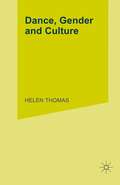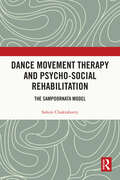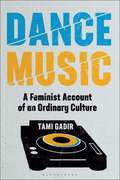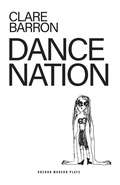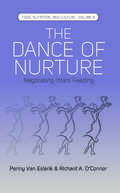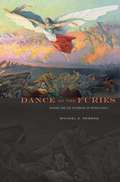- Table View
- List View
Dance for your Daddy: The True Story of a Brutal East End Childhood
by Katherine Shellduck'This morning I found this bag. I had been looking for sweets. I put my hand in the bag and felt a sticky liquid on my fingers, then I looked at it. A red smear. Then I looked in the bag: bloody knives and clothes. It didn't feel good. What did it mean? I don't know. There are no answers; I daren't ask the questions'Growing up in poverty in London's East End, Kathy was eight years old when her father forced her mother into prostitution. When their mother fled, leaving Kathy and her sisters behind, the girls stuck fiercely together while being passed from children's homes to boarding schools. Then, on a rare trip home, Kathy looked out the window to see a man firing four shots into a Rolls-Royce. It took several seconds for her to realise the victim was her mother's lover, and the gunman was her father.Kathy began her haunting memoir when, as an adult, she travelled back to London, to find out who her gangster father really was. A compelling memoir of an extraordinary childhood, Dance for your Daddy is a true story of the effects on one family of poverty and affluence, violence and love.
Dance, Gender and Culture
by Helen Thomas'...full credit to Thomas and Macmillan for embarking on such a worthwhile venture - Dance Research I have already found the Thomas edition of enormous value in teaching both undergraduates and postgraduates, from the perspectives of dance anthropology, ethnography and theatre dance analysis - Theresa Buckland, Department of Dance Studies, University of Surrey This unique collection of papers, written specially for this volume, explores the aspects of the ways in which dance and gender intersect in a variety of cultural contexts, from social and disco dance to performance dance, to the Hollywood musical and dances from different cultures. The contributors come from a broad range of disciplines, such as cultural studies, anthropology, sociology, dance studies, film studies, and journalism. They bring to the book a wide body of ideas and approaches, including feminism, psychoanalysis, ethnography and subcultural theory. List of Plates - Preface to the 1995 Reprint - Notes on the Contributors - Introduction - PART 1: CULTURAL STUDIES - Dance, Gender and Culture; T.Polhumus - Dancing in the Dark: Rationalism and the Neglect of Social Dance; A.Ward - Ballet, Gender and Cultural Power; C.J.Novack - 'I Seem to Find the Happiness I Seek': Heterosexuality and Dance in the Musical; R.Dyer - PART 2: ETHNOGRAPHY - An-Other Voice: Young Women Dancing and Talking; H.Thomas - Gender Interchangeability among the Tiwi; A.Grau - 'Saturday Night Fever': An Ethnography of Disco Dancing; D.Walsh - Classical Indian Dance and Women's Status; J.L.Hanna - PART 3: THEORY/CRITICISM - Dance, Feminism and the Critique of the Visual; R.Copeland - 'You put your left foot in, then you shake it all about ...': Excursions and Incursions into Feminism and Bausch's Tanztheater; A.Sanchez-Colberg - 'She might pirouette on a daisy and it would not bend': Images of Femininity and Dance Appreciation; L-A.Sayers - Still Dancing Downwards and Talking Back; Z.Oyortey - The Anxiety of Dance Performance; V.Rimmer - Index
Dance in the Field: Theory, Methods and Issues in Dance Ethnography
by Dr Theresa Jill Buckland Theresa J. BucklandThis international collection on dance ethnography - the first of its kind - comprises original contributions on fieldwork in dance and human movement. Based on extensive fieldwork experience, it explores the major theoretical approaches, methods and concerns of dance and movement research from anthropological and ethnochoreological perspectives. The result underlines the existing and continuing growth in dance ethnography which will also be of interest to those in dance studies, anthropology, cultural studies, folklore, ethnomusicology and sociology.
Dance in US Popular Culture
by Jennifer AtkinsThis innovative textbook applies basic dance history and theory to contemporary popular culture examples in order to examine our own ways of moving in—and through—culture. By drawing on material relevant to students, Dance in US Popular Culture successfully introduces students to critical thinking around the most personal of terrain: our bodies and our identities. The book asks readers to think about: what embodied knowledge we carry with us and how we can understand history and society through that lens what stereotypes and accompanying expectations are embedded in performance, related to gender and/or race, for instance how such expectations are reinforced, negotiated, challenged, embraced, or rescripted by performers and audiences how readers articulate their own sense of complex identity within the constantly shifting landscape of popular culture, how this shapes an active sense of their everyday lives, and how this can act as a springboard towards dismantling systems of oppression Through readings, questions, movement analyses, and assignment prompts that take students from computer to nightclub and beyond, Dance in US Popular Culture readers develop their own cultural sense of dance and the moving body’s sociopolitical importance while also determining how dance is fundamentally applicable to their own identity. This is the ideal textbook for high school and undergraduate students of dance and dance studies in BA and BfA courses, as well as those studying popular culture from interdisciplinary perspectives including cultural studies, media studies, communication studies, theater and performance studies.
Dance in US Popular Culture
This innovative textbook applies basic dance history and theory to contemporary popular culture examples in order to examine our own ways of moving in—and through—culture. By drawing on material relevant to students, Dance in US Popular Culture successfully introduces students to critical thinking around the most personal of terrain: our bodies and our identities. The book asks readers to think about: what embodied knowledge we carry with us and how we can understand history and society through that lens what stereotypes and accompanying expectations are embedded in performance, related to gender and/or race, for instance how such expectations are reinforced, negotiated, challenged, embraced, or rescripted by performers and audiences how readers articulate their own sense of complex identity within the constantly shifting landscape of popular culture, how this shapes an active sense of their everyday lives, and how this can act as a springboard towards dismantling systems of oppression Through readings, questions, movement analyses, and assignment prompts that take students from computer to nightclub and beyond, Dance in US Popular Culture readers develop their own cultural sense of dance and the moving body’s sociopolitical importance while also determining how dance is fundamentally applicable to their own identity. This is the ideal textbook for high school and undergraduate students of dance and dance studies in BA and BfA courses, as well as those studying popular culture from interdisciplinary perspectives including cultural studies, media studies, communication studies, theater and performance studies.
Dance Matters Too: Markets, Memories, Identities
by Pallabi Chakravorty Nilanjana GuptaDance Matters Too: Markets, Memories, Identities is a rich intellectual contribution to the growing field of dance studies in India. It forges new avenues of scholarly inquiry and critical engagement and opens the field in innovative ways. This volume builds on Dance Matters (2009), which mapped the interdisciplinary breadth of the field. The chapters presented here continue to underline the uniqueness of a field that is a blend of critical scholarship on aesthetics and performance with the humanities and social sciences. Including diverse material, analytical approaches and perspectives from scholars and practitioners, this multidimensional volume explores debates on dance preservation and tradition in globalizing India, multimedia choreographies and the circulation of dance via electronic media, embodiment and memory, power, democracy and bourgeoning markets, classification and censorship, and corporatization and Bollywood. This tour de force will appeal to those in dance and performance studies, cultural studies, sociology as well as to readers interested in tradition, modernity, gender and globalization.
Dance Matters Too: Markets, Memories, Identities
by Pallabi Chakravorty Nilanjana GuptaDance Matters Too: Markets, Memories, Identities is a rich intellectual contribution to the growing field of dance studies in India. It forges new avenues of scholarly inquiry and critical engagement and opens the field in innovative ways. This volume builds on Dance Matters (2009), which mapped the interdisciplinary breadth of the field. The chapters presented here continue to underline the uniqueness of a field that is a blend of critical scholarship on aesthetics and performance with the humanities and social sciences. Including diverse material, analytical approaches and perspectives from scholars and practitioners, this multidimensional volume explores debates on dance preservation and tradition in globalizing India, multimedia choreographies and the circulation of dance via electronic media, embodiment and memory, power, democracy and bourgeoning markets, classification and censorship, and corporatization and Bollywood. This tour de force will appeal to those in dance and performance studies, cultural studies, sociology as well as to readers interested in tradition, modernity, gender and globalization.
Dance Movement Therapy and Psycho-social Rehabilitation: The Sampoornata Model
by Sohini ChakrabortyThis book looks at the psychotherapeutic effects of Dance Movement Therapy (DMT) with a focus on the experiences of survivors of gender-based violence and their social development, psycho-social rehabilitation, and reintegration within society. The author, a sociologist and dancer, uses a model she calls Sampoornata— or Fulfilment, to merge sociology and dance in order to help survivors of sexual violence overcome their trauma. Sampoornata was developed to help survivors of gender-based violence and trafficking, by focusing on their specific needs, and helping them to express themselves and overcome emotional and psychological pain. Through interviews with and detailed narratives of survivors, the book takes the readers through the development of the model, its implementation, practice, and impact on their lives. Situated within the social, cultural, as well as geographical context of India, the book is an important resource for rethinking the creative approaches, theories, and practice of DMT worldwide. This book will be of interest to researchers and students of psychology, psychotherapy, dance and movement studies, and to those who work with dance and movement therapy. It will also be useful for professionals working in the areas of gender violence, trafficking, trauma, psycho-social rehabilitation, and well-being.
Dance Movement Therapy and Psycho-social Rehabilitation: The Sampoornata Model
by Sohini ChakrabortyThis book looks at the psychotherapeutic effects of Dance Movement Therapy (DMT) with a focus on the experiences of survivors of gender-based violence and their social development, psycho-social rehabilitation, and reintegration within society. The author, a sociologist and dancer, uses a model she calls Sampoornata— or Fulfilment, to merge sociology and dance in order to help survivors of sexual violence overcome their trauma. Sampoornata was developed to help survivors of gender-based violence and trafficking, by focusing on their specific needs, and helping them to express themselves and overcome emotional and psychological pain. Through interviews with and detailed narratives of survivors, the book takes the readers through the development of the model, its implementation, practice, and impact on their lives. Situated within the social, cultural, as well as geographical context of India, the book is an important resource for rethinking the creative approaches, theories, and practice of DMT worldwide. This book will be of interest to researchers and students of psychology, psychotherapy, dance and movement studies, and to those who work with dance and movement therapy. It will also be useful for professionals working in the areas of gender violence, trafficking, trauma, psycho-social rehabilitation, and well-being.
Dance Music: A Feminist Account of an Ordinary Culture (Alternate Takes: Critical Responses to Popular Music)
by Dr Tami GadirFor some people, at some times, in some places, on some drugs, dance music can be a gateway to transformative, even transcendent experiences. With the help of skilled DJs, dancers can reach euphoric states, discard their egos, and feel social barriers dissolve. Dance floors can be sites of openness, subversion, and even small-scale acts of political resistance. At a minimum, dance music lightens the burdens of contemporary life. At its best, dance music offers glimpses of better worlds. Yet even where dance music communities are built on principles of resistance and liberation, they nevertheless share the grittier realities of the rest of the world. Dance Music makes the case that dance music is ordinary and that something exceeding the social and spatiotemporal bounds of the dance floor is required for the transformative promise of dance music to be realized.
Dance Music: A Feminist Account of an Ordinary Culture (Alternate Takes: Critical Responses to Popular Music)
by Dr Tami GadirFor some people, at some times, in some places, on some drugs, dance music can be a gateway to transformative, even transcendent experiences. With the help of skilled DJs, dancers can reach euphoric states, discard their egos, and feel social barriers dissolve. Dance floors can be sites of openness, subversion, and even small-scale acts of political resistance. At a minimum, dance music lightens the burdens of contemporary life. At its best, dance music offers glimpses of better worlds. Yet even where dance music communities are built on principles of resistance and liberation, they nevertheless share the grittier realities of the rest of the world. Dance Music makes the case that dance music is ordinary and that something exceeding the social and spatiotemporal bounds of the dance floor is required for the transformative promise of dance music to be realized.
Dance Nation (Oberon Modern Plays)
by Clare Barron'Maybe this is the year, this is the moment, this is the dance where your lives will start!'Somewhere in America, a revolution is coming.An army of competitive dancers is ready to take over the world, one routine at a time.With a pre-teen battle for power and perfection raging on and off stage, Dance Nation is a ferocious exploration of youth, ambition and self-discovery.Winner of the Susan Smith Blackburn Prize and The Relentless Award, Dance Nation is Clare Barron’s explosive new play.
The Dance of Innovation: Infrastructure, Social Oscillation, and the Evolution of Societies (Evolutionary Analysis in the Social Sciences)
by Kevin McCaffreeFew of us, amidst our daily chores and responsibilities, consider how mundane infrastructures—from electrical grids to sewage systems—have developed over millennia in ways that enable everything we cherish, from democracy to technological innovation to individual liberty. But what drives the evolution of this infrastructure? And why is infrastructure so critical to human flourishing? In this book, the most innovative and interdisciplinary study of cultural evolution ever produced, new concepts are explored, new histories are brought into contact and new ground-breaking insights are defended. What makes creativity unique in human societies is not only our capacity to generate and modify our diverse individual intuitions about the social and physical world, but also our capacity to form and leave groups fluidly in a dancing rhythm of oscillation across the expanse of history. This book walks the reader carefully through these processes, with clear concepts and an approachable writing style.
The Dance of Innovation: Infrastructure, Social Oscillation, and the Evolution of Societies (Evolutionary Analysis in the Social Sciences)
by Kevin McCaffreeFew of us, amidst our daily chores and responsibilities, consider how mundane infrastructures—from electrical grids to sewage systems—have developed over millennia in ways that enable everything we cherish, from democracy to technological innovation to individual liberty. But what drives the evolution of this infrastructure? And why is infrastructure so critical to human flourishing? In this book, the most innovative and interdisciplinary study of cultural evolution ever produced, new concepts are explored, new histories are brought into contact and new ground-breaking insights are defended. What makes creativity unique in human societies is not only our capacity to generate and modify our diverse individual intuitions about the social and physical world, but also our capacity to form and leave groups fluidly in a dancing rhythm of oscillation across the expanse of history. This book walks the reader carefully through these processes, with clear concepts and an approachable writing style.
The Dance of Nurture: Negotiating Infant Feeding (Food, Nutrition, and Culture #6)
by Penny Van Esterik Richard A. O’ConnorBreastfeeding and child feeding at the center of nurturing practices, yet the work of nurture has escaped the scrutiny of medical and social scientists. Anthropology offers a powerful biocultural approach that examines how custom and culture interact to support nurturing practices. Our framework shows how the unique constitutions of mothers and infants regulate each other. The Dance of Nurture integrates ethnography, biology and the political economy of infant feeding into a holistic framework guided by the metaphor of dance. It includes a critique of efforts to improve infant feeding practices globally by UN agencies and advocacy groups concerned with solving global nutrition and health problems.
Dance of the Dolphin: Transformation and Disenchantment in the Amazonian Imagination
by Candace SlaterIn folktales told throughout much of the Brazilian Amazon, dolphins take human form, attend raucous dances and festivals, seduce men and women, and carry them away to a city beneath the river. They are encantados, or Enchanted Beings, capable of provoking death or madness, but also called upon to help shamanic healers. Male dolphins—accomplished dancers who appear dressed in dapper straw hats, white suits, and with shiny black shoes—reportedly father numerous children. The females are said to lure away solitary fishermen. Both sinister and charming, these characters resist definition and thus domination; greedy and lascivious outsiders, they are increasingly symbolic of a distinctly Amazonian culture politically, socially, economically, and environmentally under seige. Candace Slater examines these stories in Dance of the Dolphin, both as folk narratives and as representations of culture and conflict in Amazonia. Her engaging study discusses the tales from the viewpoints of genre, performance, and gender, but centers on them as responses to the great changes sweeping the Amazon today. According to Slater, these surprisingly widespread tales reflect Amazonians' own mixed reactions to the ongoing destruction of the rainforest and the resulting transformations in the social as well as physical landscape. Offering an informed view of Brazilian culture, this book crosses the boundaries of folklore, literature, anthropology, and Latin American studies. It is one of the very few studies to offer an overview of the changes taking place in Amazonia through the eyes of ordinary people. "This book is a rich collection of stories about the transformation of dolphins in the city of enchantment. . . . The joy in this book is not just its vibrant analysis and careful relating of tradition and lore, but also its uncanny accurateness in capturing the very essence of Amazonia."-Darrell Posey, Journal of Latin American Studies "Slater's fluid prose reads like a novel for those interested in Amazonian culture and folklore, while her integrated approach makes this a must read for those interested in innovative methodology."-Lisa Gabbert, Western Folklore
Dance of the Dolphin: Transformation and Disenchantment in the Amazonian Imagination
by Candace SlaterIn folktales told throughout much of the Brazilian Amazon, dolphins take human form, attend raucous dances and festivals, seduce men and women, and carry them away to a city beneath the river. They are encantados, or Enchanted Beings, capable of provoking death or madness, but also called upon to help shamanic healers. Male dolphins—accomplished dancers who appear dressed in dapper straw hats, white suits, and with shiny black shoes—reportedly father numerous children. The females are said to lure away solitary fishermen. Both sinister and charming, these characters resist definition and thus domination; greedy and lascivious outsiders, they are increasingly symbolic of a distinctly Amazonian culture politically, socially, economically, and environmentally under seige. Candace Slater examines these stories in Dance of the Dolphin, both as folk narratives and as representations of culture and conflict in Amazonia. Her engaging study discusses the tales from the viewpoints of genre, performance, and gender, but centers on them as responses to the great changes sweeping the Amazon today. According to Slater, these surprisingly widespread tales reflect Amazonians' own mixed reactions to the ongoing destruction of the rainforest and the resulting transformations in the social as well as physical landscape. Offering an informed view of Brazilian culture, this book crosses the boundaries of folklore, literature, anthropology, and Latin American studies. It is one of the very few studies to offer an overview of the changes taking place in Amazonia through the eyes of ordinary people. "This book is a rich collection of stories about the transformation of dolphins in the city of enchantment. . . . The joy in this book is not just its vibrant analysis and careful relating of tradition and lore, but also its uncanny accurateness in capturing the very essence of Amazonia."-Darrell Posey, Journal of Latin American Studies "Slater's fluid prose reads like a novel for those interested in Amazonian culture and folklore, while her integrated approach makes this a must read for those interested in innovative methodology."-Lisa Gabbert, Western Folklore
Dance of the Dolphin: Transformation and Disenchantment in the Amazonian Imagination
by Candace SlaterIn folktales told throughout much of the Brazilian Amazon, dolphins take human form, attend raucous dances and festivals, seduce men and women, and carry them away to a city beneath the river. They are encantados, or Enchanted Beings, capable of provoking death or madness, but also called upon to help shamanic healers. Male dolphins—accomplished dancers who appear dressed in dapper straw hats, white suits, and with shiny black shoes—reportedly father numerous children. The females are said to lure away solitary fishermen. Both sinister and charming, these characters resist definition and thus domination; greedy and lascivious outsiders, they are increasingly symbolic of a distinctly Amazonian culture politically, socially, economically, and environmentally under seige. Candace Slater examines these stories in Dance of the Dolphin, both as folk narratives and as representations of culture and conflict in Amazonia. Her engaging study discusses the tales from the viewpoints of genre, performance, and gender, but centers on them as responses to the great changes sweeping the Amazon today. According to Slater, these surprisingly widespread tales reflect Amazonians' own mixed reactions to the ongoing destruction of the rainforest and the resulting transformations in the social as well as physical landscape. Offering an informed view of Brazilian culture, this book crosses the boundaries of folklore, literature, anthropology, and Latin American studies. It is one of the very few studies to offer an overview of the changes taking place in Amazonia through the eyes of ordinary people. "This book is a rich collection of stories about the transformation of dolphins in the city of enchantment. . . . The joy in this book is not just its vibrant analysis and careful relating of tradition and lore, but also its uncanny accurateness in capturing the very essence of Amazonia."-Darrell Posey, Journal of Latin American Studies "Slater's fluid prose reads like a novel for those interested in Amazonian culture and folklore, while her integrated approach makes this a must read for those interested in innovative methodology."-Lisa Gabbert, Western Folklore
Dance of the Furies: Europe And The Outbreak Of World War I
by Michael S. NeibergLooking beyond diplomats and generals, Neiberg shows that neither nationalist passions nor desires for revenge took Europe to war in 1914. Dance of the Furies gives voice to a generation who suddenly found themselves compelled to participate in a ghastly, protracted orgy of violence they never imagined would come to pass.
Dance of the Furies: Europe And The Outbreak Of World War I
by Michael S. NeibergLooking beyond diplomats and generals, Neiberg shows that neither nationalist passions nor desires for revenge took Europe to war in 1914. Dance of the Furies gives voice to a generation who suddenly found themselves compelled to participate in a ghastly, protracted orgy of violence they never imagined would come to pass.
Dance of the Photons: Einstein, Entanglement and Quantum Teleportation
by Anton ZeilingerA Nobel Laureate explains quantum entanglement and teleportation and why Einstein was wrong about the nature of realityWhat is the true nature of reality? To find out, Nobel Laureate Anton Zeilinger takes us (along with his fictional students Alice and Bob) on a voyage through a quantum wonderland, explaining entanglement, teleportation, time-travel paradoxes and why our view of the world must change.Originally published in America in 2012, a new Afterword in the light of the author's 2022 Nobel Prize means the book brings readers up-to-date with the most recent developments in quantum teleportation. This describes the author's collaboration to perform the first intercontinental video call encrypted using quantum cryptography, and how Chinese scientists teleported entangled quantum states to an orbiting satellite. Readers also learn how both volunteer humans and astronomical objects billions of light years away have been part of experiments to conclusively prove that quantum states cannot provide a full description of reality at a local level.Einstein had always refused to accept aspects of quantum theory, deriding the notion of instantaneous communication between faraway 'entangled' particles as 'spooky action at a distance'. However, this playful yet deep book takes readers through a series of ingenious experiments conducted in various locations that demonstrate entanglement is indeed real, and speculates that information is an essential part of reality.From a dank sewage tunnel under the River Danube to the balmy air between a pair of mountain peaks in the Canary Islands, with various time-travel paradoxes explained along the way, the author and his fictional physics students Alice and Bob demonstrate the true nature of quantum entanglement and teleportation using photons, or light quanta, created by laser beams. The ideas described have laid the foundations for a new era of quantum technology, including the development of quantum computers and much more.
Dance On!: Dancing through Life
by Stephanie Burridge Charlotte Svendler NielsenBurridge and Svendler Nielsen bring together many perspectives from around the world on dancing experiences through life of senior artists and educators, whether as professionals working with community dance groups, in education or for recreation and well-being. Broadening our understanding of the burgeoning sector of maturing dances and dancers, this book incorporates a range of theoretical approaches with an emphasis on cultural and experiential dimensions. It includes examples of how artists, community practitioners, teachers, policy makers and academics work to better understand, promote and create new ways of thinking and working in the field of dance performance, education and well-being. Each section of the book includes a mixture of chapters based on research and case narratives focusing on practitioners’ experience, as well as conversations between world-renowned mature dance artists and choreographers. It features an eclectic mix of lived experiences, wisdom, deep knowledge and reflection. The book is a valuable resource for students of performing arts, pedagogy, choreography, community dance practice, social and cultural studies, aesthetics, interdisciplinary arts, dance therapy and more. Artists working across generations and in communities can also find useful inspiration for their continued dance practice.
Dance On!: Dancing through Life
Burridge and Svendler Nielsen bring together many perspectives from around the world on dancing experiences through life of senior artists and educators, whether as professionals working with community dance groups, in education or for recreation and well-being. Broadening our understanding of the burgeoning sector of maturing dances and dancers, this book incorporates a range of theoretical approaches with an emphasis on cultural and experiential dimensions. It includes examples of how artists, community practitioners, teachers, policy makers and academics work to better understand, promote and create new ways of thinking and working in the field of dance performance, education and well-being. Each section of the book includes a mixture of chapters based on research and case narratives focusing on practitioners’ experience, as well as conversations between world-renowned mature dance artists and choreographers. It features an eclectic mix of lived experiences, wisdom, deep knowledge and reflection. The book is a valuable resource for students of performing arts, pedagogy, choreography, community dance practice, social and cultural studies, aesthetics, interdisciplinary arts, dance therapy and more. Artists working across generations and in communities can also find useful inspiration for their continued dance practice.
Dance on Screen: Genres and Media from Hollywood to Experimental Art
by S. DoddsDance on Screen is a comprehensive introduction to the rich diversity of screen dance genres. It provides a contextual overview of dance in the screen media and analyzes a selection of case studies from the popular dance imagery of music video and Hollywood, through to experimental art dance. The focus then turns to video dance, dance originally choreographed for the camera. Video dance can be seen as a hybrid in which the theoretical and aesthetic boundaries of dance and television are traversed and disrupted. This new paperback edition includes a new Preface by the author covering key developments since the hardback edition was published in 2001.
Dance Practices as Research: Approaches to the Safeguarding and Transmission of the Intangible Cultural Heritage of Dance (Heritage Studies)
by Vicky KämpfeThis book contributes to the growing scientific literature on ‘intangible cultural heritage’ – determined by UNESCO to be particularly worthy of safeguarding and transmission – by advancing a theoretical-analytical framework for the (in)tangible cultural heritage of dance. By exploring the potential of the ‘intangible materiality’ of dance practice the book argues that implementing the concept of a ‘performative dance-archive’ creates a new analytic field: research in praxis. The concept of the ‘performative dance-archive’ draws out the potential for safeguarding and transmission of dance heritage, but also the challenges of the opposition between living heritage and the codifying of cultural inventories. This book uses the formal and contextual transformation of Argentine tango and German modern dance to discuss this ambiguity of intangible heritage and how the “performative dance-archive” creates a cognitive, empractical approach to determine, archive, and distribute dance knowledge. This is a timely methodological intervention in the context of the increasing importance of the intangible cultural heritage. It enables us to re-revise the concept of (im)materiality and the specific knowledges within cultural practice as a necessary fundamental category for research-processes and societal growth. This book is directed both to researchers in the field of intangible cultural heritage and to practitioners and researchers searching for new ways of investigating methods and perspectives to understand 'immaterial materialities'.

